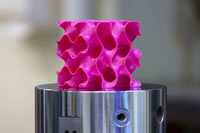3D graphene: MIT scientists develop super-light, super-strong structure
 Weston Williams for The Christian Science Monitor: Many scientists consider graphene to be one of the most potentially useful materials ever created. The atom-thick chain of carbon atoms are strong, light, and promise many applications, from energy storage to pollution removal to waterproof coating.
Weston Williams for The Christian Science Monitor: Many scientists consider graphene to be one of the most potentially useful materials ever created. The atom-thick chain of carbon atoms are strong, light, and promise many applications, from energy storage to pollution removal to waterproof coating.
While graphene has been studied since the 1940s, scientists have had considerable trouble constructing it into a structurally useful form on a three-dimensional level. But now, scientists at MIT have figured out how to build up graphene into useful, 3-D shapes with the potential to be lighter and stronger than steel.
The new research marks an important step forward for the material. The hexagonal structure is essentially an "unrolled" carbon nanotube only an atom thick, usually only functional on a two-dimensional level. Despite this limitation, graphene is more than 100 times stronger than steel, and converting that two-dimensional strength into a structure usable for three-dimensional building materials has for years been something of a holy grail for graphene researchers. And now, scientists may be one step closer to that conversion. Cont'd...
Comments (0)
This post does not have any comments. Be the first to leave a comment below.
Featured Product

